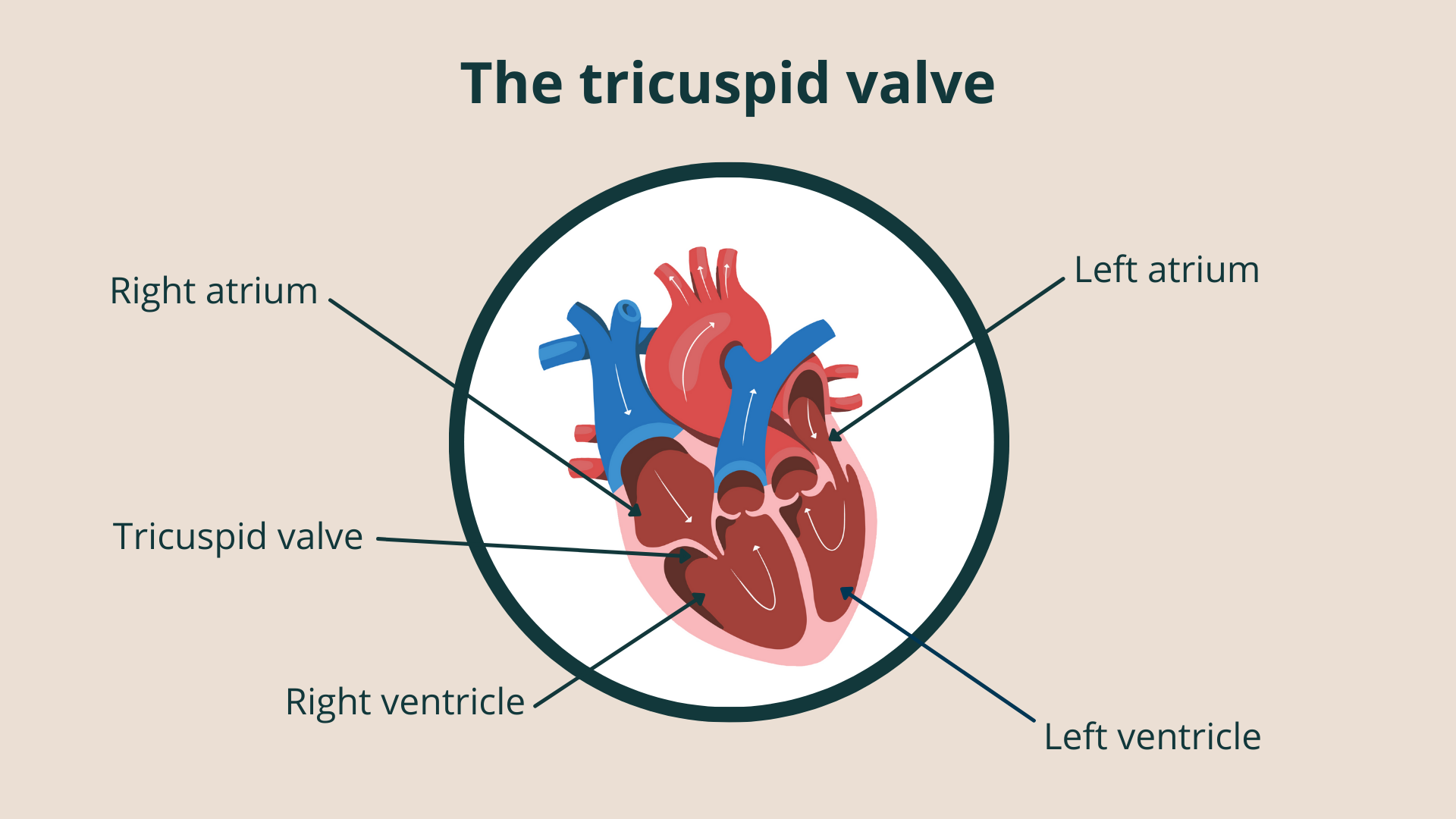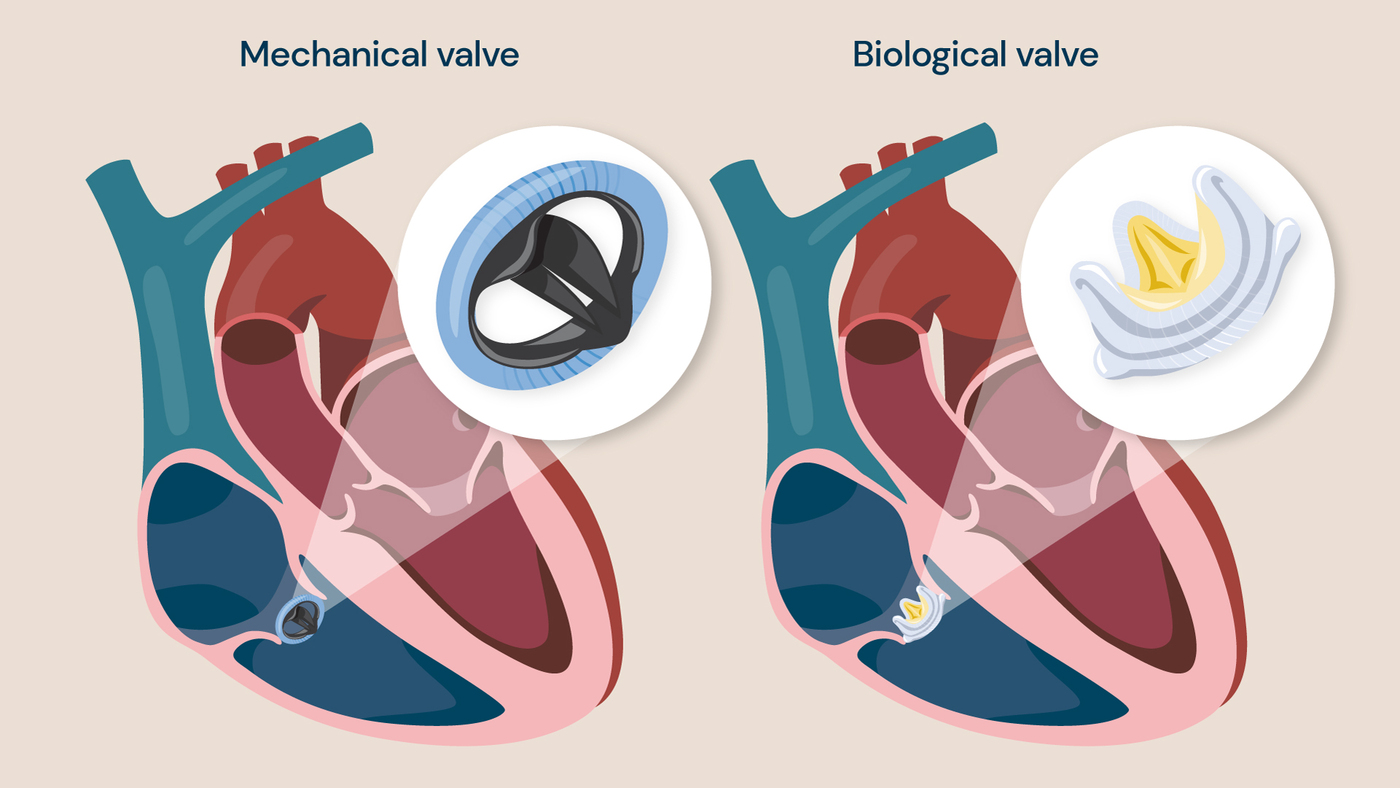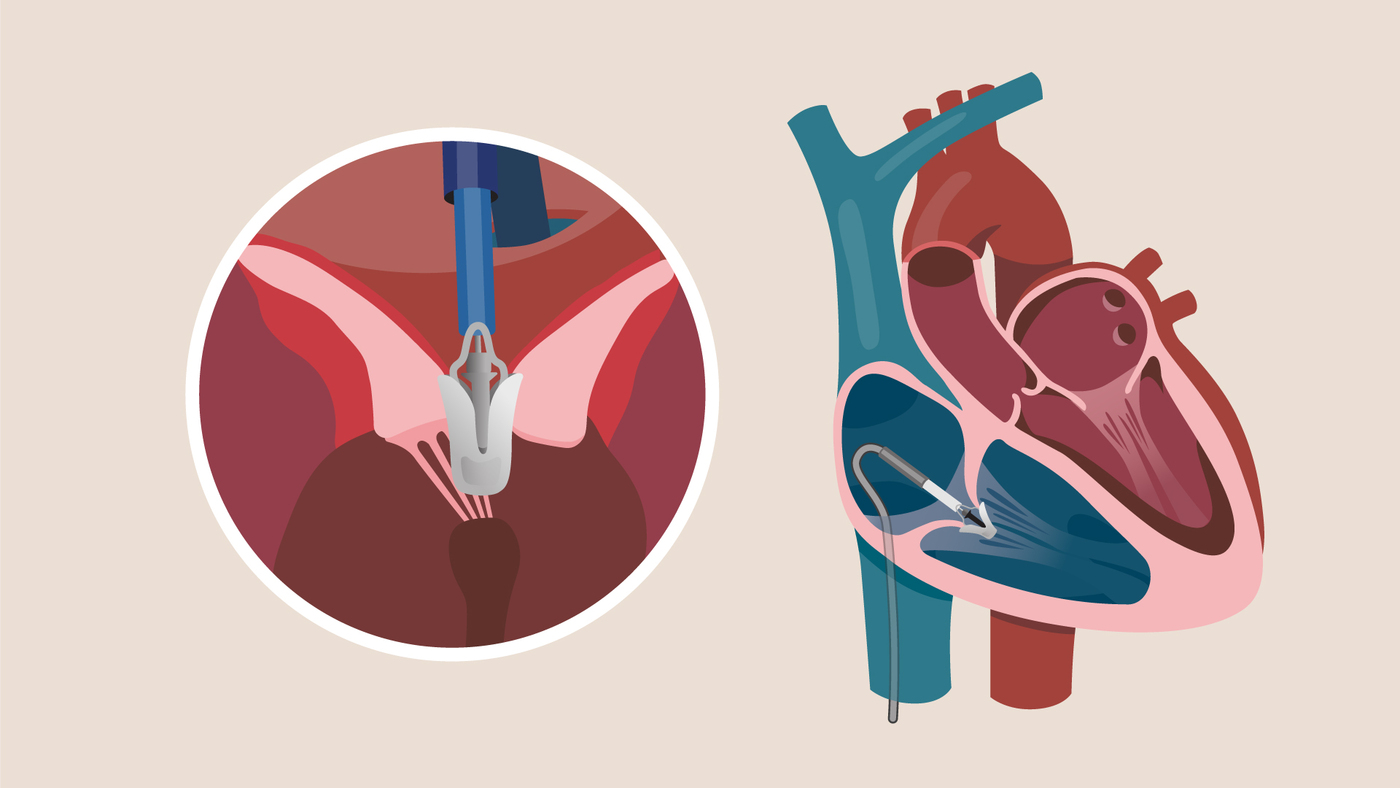What is the tricuspid valve?
The tricuspid valve is a small flap in your heart that controls the direction of blood flow, preventing it from going in the wrong direction with each heartbeat. The valve is located between the right atrium and right ventricle (the right-hand chambers) of your heart.

The tricuspid valve is located between the right atrium and right ventricle of the heart.
Tricuspid valve repair and replacement are two types of procedures performed to treat different forms of tricuspid valve disease.
These procedures have been developed to improve blood flow through your heart and lower your risk of developing further heart-related conditions. They can be performed as open-heart surgery or minimally invasive surgical or non-surgical procedures.
The type of tricuspid valve procedure recommended will depend on key factors, which include your age and how severe your condition is, as not all types of procedures are suitable for everyone.
What is tricuspid valve disease?
Tricuspid valve disease can present in different forms:
- Tricuspid valve regurgitation – where your blood flows backwards through the tricuspid valve, which is often due to elevated blood pressure in the right part of the heart due to heart disease affecting the left side. Sometimes it is due to a congenital heart condition called Ebstein’s anomaly or dysplastic tricuspid valve. Occasionally it is secondary to previous or current infection of the valve tissue causing the valve to leak.
- Tricuspid valve stenosis – where the tricuspid valve becomes narrowed or blocked, making it difficult for blood to flow through the valve as it should.
- Tricuspid atresia – a congenital heart condition present at birth where the tricuspid valve has not formed and solid tissue restricts blood flow between the chambers of your heart.
You will be recommended a procedure to repair or replace a damaged tricuspid valve when your condition becomes severe enough.
Treatment for tricuspid valve disease
Tricuspid valve repair and replacement are both used to treat tricuspid valve disease. However, there are key differences between the two procedures that determine which is recommended.
In addition to open-heart surgery, there are minimally invasive surgical and non-surgical options available at Royal Brompton and Harefield hospitals to treat tricuspid valve disease.
What is a tricuspid valve repair?
A tricuspid valve repair is often the first step in treating tricuspid valve regurgitation or stenosis.
It can be performed as an open-heart surgery, minimally invasive keyhole surgery or minimally invasive non-surgical procedure, depending on the type of problem you have.
To repair your tricuspid valve, a specialist may:
- seal holes or tears in your valve
- reconnect valve flaps
- remove or shape excess tissue
- replace the chords that support your valve
- separate any valve flaps that may have fused
- use a device to clip loose valve flaps together
- tighten or strengthen with a ring around your valve
What is a tricuspid valve replacement?
If your tricuspid valve disease is severe and cannot be repaired, it must be replaced.
During a tricuspid valve replacement, your diseased or damaged tricuspid valve will be removed and replaced with usually one made of biological tissue. In rare cases, a mechanical valve is used (made of carbon fibre).

During a tricuspid valve replacement, the valve is replaced with either a mechanical valve or a biological valve.
If you have a mechanical valve, you will be given blood thinners to reduce your risk of blood clots. These medicines will need to be taken for the rest of your life. There are risks associated with this medication such as bleeding complications and blood clots forming.
Valves made with biological tissues, on the other hand, would often require blood thinners for a limited amount of time but can degrade over time and need replacing in future. However, they should last between 10 and 15 years before they require replacing.
Tricuspid valve replacement can be performed as an open-heart surgery. However, minimally invasive keyhole surgery is available for appropriate patients at Royal Brompton and Harefield hospitals. Your doctor will recommend the best option based on your state of health, age, and other factors.
Minimally invasive tricuspid valve repair and replacement
Our heart specialists at Royal Brompton and Harefield hospitals are world-renowned in minimally invasive tricuspid valve repair and replacement and have helped pioneer several techniques. Explore our minimally invasive procedures below.
Transcatheter repair for tricuspid valve regurgitation
A tricuspid valve repair can be performed as a minimally invasive procedure for tricuspid valve regurgitation, using a catheter – a tube-like device – to direct treatment to your heart via a small incision in your groin. This avoids the need for open-heart surgery by transcatheter edge-to-edge repair (TEER) of the valve.

(Left) Edwards PASCAL transcatheter valve repair system, with the PASCAL ACE implant and (right) the Abbott TriClip Transcatheter Valve Repair system, offers our interventional cardiologists a range of implant options to suit each patient’s individual needs.
A leaflet repair apparatus (see images) is attached to the tricuspid valve leaflets which helps them seal correctly as they open and close with each heartbeat. This helps treat the problem of tricuspid valve regurgitation specifically with a range of implant options tailored to each patient’s individual needs.
Most patients who have a transcatheter tricuspid valve repair procedure recover quickly. They normally return home one to 2 days after the procedure and return to their regular routines shortly after that.
The procedure is of particular benefit to patients who are too high-risk for open-heart tricuspid valve repair, such as if they are older, have additional health issues, or have advanced heart failure.
Royal Brompton and Harefield hospitals are some of the few centres in the world that currently offer this procedure, with high procedural numbers to date.
Endoscopic (keyhole) tricuspid valve repair and replacement
Our consultant cardiac surgeons have developed a new, endoscopic (keyhole) procedure to repair or replace a damaged tricuspid valve. This innovative procedure is an alternative to open-heart surgery (where the breastbone is cut) in selected patients.
A small incision is made between the ribs to place an endoscope (a thin flexible tube with a camera at the end) to help the surgeon navigate to the heart. A high-definition 3D camera is used to direct the procedure inside your heart, and it is completed in around 4 hours.
An endoscopic tricuspid valve repair or replacement can reduce recovery times when compared to open-heart surgery. It can also reduce the size of the surgical scar as only a small incision is made. Studies have also shown that this procedure is just as safe.
Patients are normally discharged from the hospital within 4 days post-surgery and can return to normal activities (such as driving) within 3 weeks. With open-heart surgery, patients can take up to three months to return to normal activities.
Our surgeons have completed almost 1,000 endoscopic heart procedures at our hospitals, making them highly experienced.
Open-heart tricuspid valve repair
For a significant number of patients, conventional repair of the valve through a limited breastbone cut is still the more appropriate procedure. Most tricuspid valves that leak can be repaired in the hands of experienced surgeons.
How to prepare for a tricuspid valve repair or replacement
Preparing for a tricuspid valve procedure is important.
Before your procedure, you may need to have an echocardiogram performed so that your doctor can collect further information about your heart valves. They will also advise you on any medications you should stop taking and highlight how long in advance to stop eating and drinking.
Some items you might be asked to bring on the day of your procedure can include:
- a list of all medications you take
- any glasses, hearing aids or dentures
- things that help you relax such as books
- loose-fitting clothing
- personal care items like a hairbrush, toothbrush, or shaving equipment
During the procedure itself, you will need to remove:
- contact lenses
- dentures
- jewellery
- nail polish
Risks and complications of tricuspid valve repair or replacement
All minimally invasive and surgical procedures have some risks and complications associated with them, but with tricuspid valve repair and replacement, they are relatively low.
The most common risks associated with these procedures include:
- infection
- bleeding
- blood clots
- irregular heart rhythm
- valve replacement failure
- stroke
It is important to remember that these risks are rare and both tricuspid valve repair and replacement procedures are successful more often than not.
Tricuspid valve repair or replacement results and recovery
Tricuspid valve repair or replacement not only promotes a healthier heart and improves its function, but it also reduces your risk of further heart-related conditions.
After your tricuspid valve repair or replacement, it is important to focus on your recovery, the length of which will vary depending on the type of procedure you had.
If you had open-heart surgery, for example, the recovery process can take several months. However, if you had a minimally invasive procedure performed, it could be much shorter. How fast you recover will also depend on your overall health and whether there were any complications during or after the surgery.
You will need to have regular check-ups after your surgery, as well as tests to monitor your heart health.
The benefits of your tricuspid valve procedure include:
- reducing or eliminating symptoms, such as tiredness, feeling breathless and weak
- helping you participate in activities you enjoy and completing daily tasks
- lengthening your life
Following a healthy lifestyle can also help ensure you get the best results from your surgery. Some great ways to achieve this include:
- exercising regularly – make sure you speak with your doctor about when the time is right for you to begin exercising again
- managing your weight
- eating a well-balanced diet
- lowering your stress levels
- avoiding smoking
- reducing your alcohol intake
Related services
-
Cardiac MRI scan (CMR)
A cardiac magnetic resonance (CMR) scan is non-invasive and shows detailed images of your heart.
-
Diagnostic tests for heart conditions
We offer a range of diagnostic tests at our state-of-the-art facilities.
-
Electrocardiogram (ECG)
An electrocardiogram (also known as an ECG) is a test which is used to check your heart’s rhythm and electrical activity.
-
Echocardiogram
An echocardiogram – also known as an echo – is a scan that examines the heart and surrounding blood vessels.
-
Heart failure
Heart failure occurs when the heart stops being able to pump blood around the body in an efficient way.
-
Heart valve repair or replacement
Heart valve surgery can repair or replace a damaged valve.
-
Tricuspid regurgitation
Tricuspid regurgitation is when the tricuspid valve of the heart doesn't close properly.
-
Valvular heart disease
Heart valve disease occurs when the valves of the heart become diseased or damaged.
Locations
Discover our cardiology and cardiac surgery specialists
Meet our team of world renowned cardiology and cardiac surgery specialists. From cardiovascular health assessments to innovative interventions, our experts are committed to delivering personalised care designed just for you.

